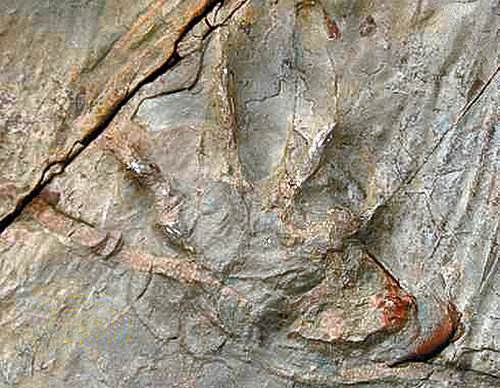Footprint fossils near Bangudae Petroglyphs are discovereid to be Choristodera’s
Footprint fossils near Bangudae Petroglyphs are discovereid to be Choristodera’s
Posted September. 05, 2020 07:26,
Updated September. 05, 2020 07:26

The footprint fossils near Bangudae Petroglyphs in Ulju, Ulsan found in June 2018 have been discovered to be Choristodera’s, a semiaquatic reptile from 100 million years ago. The ancient reptile’s footprint fossils were found only once in the world, but these are the first ones to have full shapes.
The National Research Institute of Cultural Heritage under the Cultural Heritage Administration announced on Friday that the institute published such findings in Scientific Reports, a sister journal of Nature, on Wednesday. The research was conducted by senior art and science researcher Gong Dal-yong and art and science researcher Jung Seung-ho of the National Research Institute of Cultural Heritage, as well as a team led by Professor Lee Yeong-nam of the School of Earth and Environmental Sciences at Seoul National University who is an expert in vertebrate paleontology.
Choristodera appeared in the Mesozoic era and became extinct in the Cenozoic period. Its footprint fossils were first found in Colorado in 1995, but the distinction between forefoot and hindfoot was impossible due to their poor conditions.
Meanwhile, the footprint fossils named Novapes Ulsanensis, which includes the name of the site, Ulsan, have nine forefoot and nine hindfoot that have maintained full shapes. It is the only tracksite that helps identify Choristodera’s gait and behavioral patterns.
Given the average length of Novapes Ulsanensis’ forefoot and hindfoot at 2.94 centimeters and 9.88 centimeters, respectively, Choristodera is estimated to be 90 to 100 centimeters long. It had five toes in both feet and a long tail. Its hindfeet are thought to be webbed, making it adaptable to the aquatic environment. In addition, it was confirmed for the first time that the ancient reptile walked semi-erect like an alligator, which is different from the walking pattern of dinosaurs.
Min Kim kimmin@donga.com
Headline News
- Joint investigation headquarters asks Yoon to appear at the investigation office
- KDIC colonel: Cable ties and hoods to control NEC staff were prepared
- Results of real estate development diverged by accessibility to Gangnam
- New budget proposal reflecting Trump’s demand rejected
- Son Heung-min scores winning corner kick







